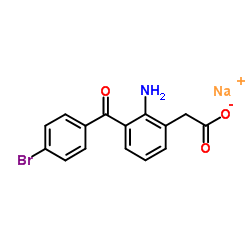Ocular penetration and anti-inflammatory activity of ketorolac 0.45% and bromfenac 0.09% against lipopolysaccharide-induced inflammation.
L David Waterbury, Danielle Galindo, Linda Villanueva, Cathy Nguyen, Milan Patel, Lisa Borbridge, Mayssa Attar, Rhett M Schiffman, David A Hollander
Index: J. Ocul. Pharmacol. Ther. 27(2) , 173-8, (2011)
Full Text: HTML
Abstract
Anti-inflammatory activity of topical nonsteroidal anti-inflammatory drugs is mediated by suppression of cyclooxygenase (COX) isoenzymes. This study compared ocular penetration and inflammation suppression of topical ketorolac 0.45% and bromfenac 0.09% ophthalmic solutions in a rabbit model.At hour 0, 36 rabbits received ketorolac 0.45%, bromfenac 0.09%, or an artificial tear 3 times once every 20 min. Half of the rabbits in each group then received intravenous injections of lipopolysaccharide (LPS) and fluorescein isothiocyanate (FITC)-dextran at hour 1, and the other half at hour 10. Aqueous and iris-ciliary body (ICB) samples were collected in the former group at hour 2 (peak) and in the latter group at hour 11 (trough) An additional group of 6 animals received only FITC-dextran, and samples were collected 1 h later. Peak and trough nonsteroidal anti-inflammatory drug concentrations were compared with previously determined half-maximal inhibitory concentrations (IC(50)) for COX isoenzymes.Peak and trough aqueous and ICB concentrations of ketorolac were at least 7-fold or greater than those of bromfenac. At peak levels, both ketorolac 0.45% and bromfenac 0.09% significantly inhibited LPS-induced aqueous prostaglandin E(2) and FITC-dextran elevation (P < 0.01). At trough, both study drugs significantly inhibited LPS-induced aqueous prostaglandin E(2) elevation (P < 0.05), but only ketorolac 0.45% significantly reduced LPS-induced aqueous FITC-dextran elevation (P < 0.01). Aqueous and ICB ketorolac concentrations exceeded its IC(50) for COX-1 and COX-2 at peak and trough. Aqueous and ICB bromfenac levels exceeded its IC(50) for COX-2 at peak and trough, but not for COX-1 at trough aqueous levels and peak and trough ICB levels.Both ketorolac 0.45% and bromfenac 0.09% effectively suppressed inflammation at peak. At trough, only ketorolac 0.45% effectively suppressed inflammation as measured by FITC-dextran leakage. The difference in inflammation suppression may be due to differences in tissue concentrations and/or greater COX-1 suppression by ketorolac 0.45%.
Related Compounds
| Structure | Name/CAS No. | Molecular Formula | Articles |
|---|---|---|---|
 |
Bromfenac Sodium
CAS:91714-93-1 |
C15H11BrNNaO3 |
|
Multiparametric assay using HepaRG cells for predicting drug...
2015-07-02 [Toxicol. Lett. 236 , 16-24, (2015)] |
|
Efficacy of ophthalmic nonsteroidal antiinflammatory drugs i...
2009-09-01 [J. Cataract Refract. Surg. 35(9) , 1614-8, (2009)] |
|
Cyclooxygenase (COX)-inhibiting drug reduces HSV-1 reactivat...
2009-03-01 [Curr. Eye Res. 34(3) , 171-6, (2009)] |
|
Aqueous prostaglandin E(2) of cataract patients at trough ke...
2009-06-01 [Adv. Ther. 26(6) , 645-50, (2009)] |
|
Comparison of efficacy of bromfenac sodium 0.1% ophthalmic s...
2009-06-01 [J. Ocul. Pharmacol. Ther. 25(3) , 265-70, (2009)] |